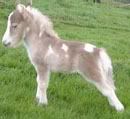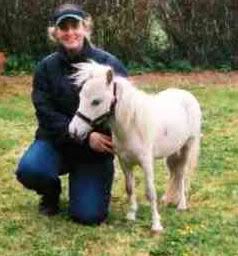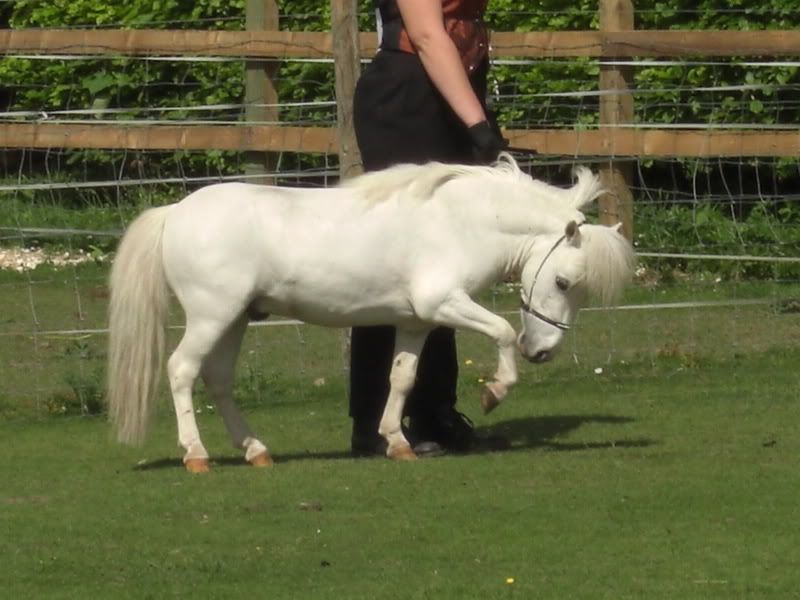Dilutions In Horses
Cream
Cream is what is known as an incomplete dominant mutation, meaning that it expresses differently in its heterozygous and homozygous forms. Cream affects only red pigment in its heterozygous form, but affects black and red pigment in its homozygous form. There is a genetic test for cream, and the designation for a heterozygous cream is N/Cr, and for a homozygous form is Cr/Cr. A single cream dilute (heterozygous) has a 50% chance of passing on cream to its offspring. A double cream dilute (homozygous) has a 100% chance of passing on cream to its offspring, regardless of the color of its mate.
Single cream dilutes:
- Buckskin
- A bay horse whose coat is diluted to a golden color, while the black pigment on the points is unaffected. The main body shade can vary from light to dark, with dark skin and eyes. Occasionally, foals are born with blue eyes, usually a slate blue color, and these normally darken with age. Some heavily diluted buckskins may appear to be almost white, or silvery in color, with brown colored, or minimal points. In these cases, a wild bay base coat is often suspected. Likewise, some buckskins appear very dark, with almost no dilution, and in these cases a dark bay (seal or brown) phenotype is suspected. Buckskin and bay dun horses are easily mistaken for each other. Buckskin and Amber Champagne horses also share a similar phenotype.
- Palomino
- A red horse (chestnut or sorrel) who is diluted to a golden shade over their entire body. They can be as dark as a true chestnut or appear almost white. They usually have a white, cream or silver mane and tail. Self colored manes and tails occur, but this is rare. Their eyes and skin are usually dark, but some palominos never attain full pigmentation. They may be born with blue eyes that never fully darken, and pinkish skin which develops mottling or freckles. They are very easily confused with the Gold Champagne phenotype, and also occasionally with flaxen chestnuts.
- Smokey Black
- A black horse typically shows no signs of carrying cream. The foal coat may be particularly light, or the adult coat may be prone to sun-bleaching, or a perpetually faded color. Some horses have lighter, amber colored eyes. But these characteristics can also occur on black horses who do not carry cream. Smokey blacks are fully capable of producing cream dilute foals, and many breeders have been surprised when a palomino, buckskin, or double dilute foal is produced by a plain black horse.
A palomino Thoroughbred gelding with sooty dappling in his coat. Photo courtesy of his breeder Norsire Farms

Smokey black (The Promise Goldun x The Promise Bon Jovi) from The Promise Welsh,
photo by Beth Wieland
Double Dilutes:
- Perlino
- A bay based horse who is completely diluted. They have a white to cream body color and cream or dark cream points. They have pink skin and blue eyes.
- Cremello
- A red based horse is turned a white to cream color, with a white or cream mane and tail. They have pink skin and blue eyes.
- Smokey Cream
- A black based horse has a cream or dark cream colored body, mane and tail, with pink skin and blue eyes.
Dun
Dun is a simple dominant mutation that affects both red and black pigment. Dun appears to lighten the base coat, but usually leaves the color of the mane, tail, and legs alone. Dun horses also show primitive markings, such as striping down the back and legs, and other parts of the body. This association is so strong and consistent, a horse is not believed to be dun unless they exhibit at least a dorsal stripe. But not all horses with primitive markings are dun. Primitive markings which occur on non-dun horses are considered a form of countershading. Foals frequently exhibit these markings, and they usually disappear when the foal coat is shed. But in some cases, the markings persist into adulthood. Horses with the sooty factor often have false primitive markings, and gray horses often show them during the graying process. In many breeds, dun is also the traditional term for any yellow horse with dark points. It is quite common, for instance, for buckskin horses to simply be called dun. And white markings can obscure or prevent identification of dun striping. All of this can lead to confusion over whether a horse is dun or not. These issues have caused dun to be one of the most confusing and difficult coat colors to positively identify. An individual horse can have primitive markings, and a diluted coat color, but this does not mean the horse is dun. One or both parents must also be dun. The breed of the horse should have documented evidence of dun, or of a comparable dilution phenotype. The pedigree of the horse can be examined for evidence of dun, and if used for breeding, the offspring as well. There is currently no direct test for dun. But UC Davis does offer a zygosity test, which is able to identify markers associated with the mutation in its hetero- and homozygous forms. This test is not available for Spanish breeds, such as Andalusian or Lusitano horses. Dun is believed to be the oldest form of equine coloration, and the original wild color of the domestic horse. It is found in cave paintings, and in other equine species, such as the donkey and the wild ass. Przewalski's Horse, the last living wild horse population, is exclusively bay dun in color. Types of dun are:
- Bay Dun (Dun, Zebra Dun)
- This is the most common type of dun. They usually have a tan body with black points, and often appear identical to buckskin horses, but with stronger primitive markings. Dun and cream can occur together, and when this happens, the horse may be called a dunskin.
- Red Dun (Fox Dun)
- A horse with a red (chestnut or sorrel) base coat. The points are generally a shade darker than the main body, but the mane and tail may also be lighter. This color can be difficult to identify because the dilution and primitive markings may be subtle or not apparent. When it occurs with cream, the horse may be called a dunalino or linebacked palomino.
- Black Dun (Grullo, Blue Dun, etc.)
- A horse with a black base coat. They have black points and usually a face mask. This is the most sought after form of dun, and is prone to misidentification. They are usually a grey color, but have no relation to the color roan or to true grey. They can be nearly black, or have a mousy color. There are many different colloquial terms to describe shades of black dun.
Champagne
Champagne acts a simple dominant gene. It dilutes the body and points of the horse. Champagne horses are born with bright blue eyes, brown hooves and pink skin. As they grow, pigmentation begins to appear in their eyes and skin. The eyes gradually darken, becoming blue-green and then an amber color with age. They can also stay blue-green or darken even further to a normal color. The pink skin develops freckles all over the body, and may tan and become darker with age. Foals are often darker when they are born, but when adult they do not lighten with further aging like grey does. Champagne horses often have an iridescent shine to the coat and may also display reverse dappling, but these traits occur on non-champagne horses as well. In the past, champagne horses were thought to be variants of cream or dun, but there is now a genetic test for champagne. The designation for a heterozygous champagne is N/Ch and for a homozygous champagne is Ch/Ch. The different types of Champagne are:
- Amber Champagne
- Bay based horses have a golden body, ranging in shades from light to dark, and with points from light brown to black. They can be mistaken for a buckskin.
- Gold Champagne
- Red (chestnut or sorrel) based horses are shades of gold with a mane and tail color that ranges from white to the same color as the body (self colored). They often appear identical to palominos, and care must be taken not to confuse the two genotypes. Older champagne horses, whose eyes and skin have darkened, are especially prone to this mistake; and there are also some palomino horses who display a heavy dilution with lighter eyes or mottled skin.
- Sable Champagne
- The result of a dark bay, brown or seal phenotype and not a classic bay.
- Classic Champagne
- Black based horses appear to be a sort of grey or chocolate metallic shade. They have dark points that may or may not be visible. They can be mistaken for a black dun color.

Eye and Skin Characteristics A, B and C) Eye and skin color of foals. D and E) Eye color and skin mottling of adult horse
Pearl
The Pearl gene is also known as the "Barlink factor." It resembles the champagne and cream mutations, but is neither. It is an incomplete recessive gene, with one copy doing nothing to the coat, while two copies will mimic champagne. When one copy of pearl and one copy of cream is present, a pseudo-double-cream-dilute color is the result. Many breeders theorize that pearl and cream are located at the same locus, meaning that a horse with both cream and pearl will only pass one or the other but not both to its offspring. Pearl has been located by UC Davis and they offer a test but they have not published their findings, so we cannot at this time know for certain if this theory is correct.

Guindaleza R (1 pearl and 1 cream gene) and Alijo, confirmed perlino foal. Photo by Bob Langrish, courtesy of Sommer Ranch

Balitor is a confirmed pearl carrier. Photo by Bob Langrish, courtesy of Sommer Ranch
Silver
Silver is believed to affect black pigment only. The body and legs usually become a chocolate color, while the mane and tail appear silvery/flaxen. Dappling may or may not appear. The roots of the mane and tail often stay dark. Sometimes only the tips show dilution, or there are only a few lighter hairs mixed in with the base color. Silver is known to produce extreme changes in shade. This can occur between seasonal coat sheds, or from the foal shed to the adult coat. Foals commonly have a wheat colored coat, white eyelashes and striped hooves, but these characteristics fade over time. Silver horses with the graying gene have been observed to gray faster than a horse without the silver gene. Silver dapple was the original name for the phenotype, before it was realized that dapples did not always occur. In Australia, silver is called taffy. Silver is selectively bred for in the Rocky Mountain Horse and the color is called Chocolate, Chocolate Flax or Red Chocolate. Silver is a dominant mutation, but it is still being investigated whether homozygous horses show more dilution than heterozygous horses. There is a genetic test for silver, and the designation for a heterozygous silver is N/Z and for a homozygous silver is Z/Z. The color remains relatively rare in the general horse population, but the number of breeds which have been confirmed to have Silver is growing. The two types of silver are:
- Black Silver (Chocolate, Silver Dapple)
- A black horse with silver can range in shade from creamy to nearly black in color. The mane and tail can be from white to a color similar to the base coat, or appear sooty. The body commonly has dapples. They were traditionally mistaken for flaxen liver chestnuts, or very sooty palominos. But the roots of the hair and the lower legs are both areas which usually appear lighter in true chestnut horses.
- Bay Silver (Red Chocolate)
- A bay horse will have diluted black points. A standard bay horse will be unaffected on the body, but a dark bay coat may show dilution. The mane and tail are generally lighter, or a sooty silver color. The legs are usually diluted to a brown/grey color, often with mottling.


Chywoon Rusty's Applause 28" AMHA stallion, Silver Black Tobiano with greying. An example of how fast a silver with gray will gray. Photos courtesy of owner.


Plum - black silver, and Beegee - silver bay. Photo courtesy of Rebecca Bermudez, Pipsqueak Paddocks Miniature Horse Haven
Mushroom
Mushroom has an autosomal recessive mode of inheritance, and it only dilutes red pigment. As a result, it is much more noticeable on red based horses, although bays can be affected as well. It often resembles Silver in expression. Mushroom has only been found in Shetland Ponies and occasionally in Miniature Horses.
Comments Page
My new filly
Hello, this year we had our first albine filly in our farm. Youc an see it in this link of our website:











My new filly
Hello, this year we had our first albine filly in our farm. Youc an see it in this link of our website:
[url=http://www.yeguadadimoba.com/potra-albi…]